NCERT Solutions Class 10 Social Science Chapter 3 Gender Religion and Caste
NCERT Solutions for Social Science Class 10 Political Science Chapter 3 Gender Religion and Caste contain the solutions to the In-chapter questions and exercises given in the Political Science book – Democratic Politics-II. In this chapter, students will mainly find questions related to the vertical division of power-sharing among different levels of government. These NCERT Solutions provide the answers to all questions in a simple and easy-to-understand way. Attempting these answers in the exam will surely help the students in scoring high marks.
NCERT Solutions
Intext Questions
Question.1. 
Question.2. 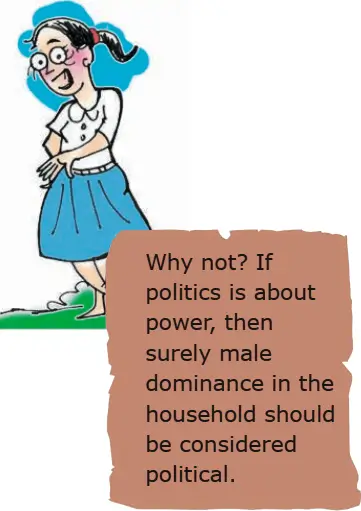
If politics ends at home or women get equal rights, women will get equal chances in all spheres of life.
Question.3. 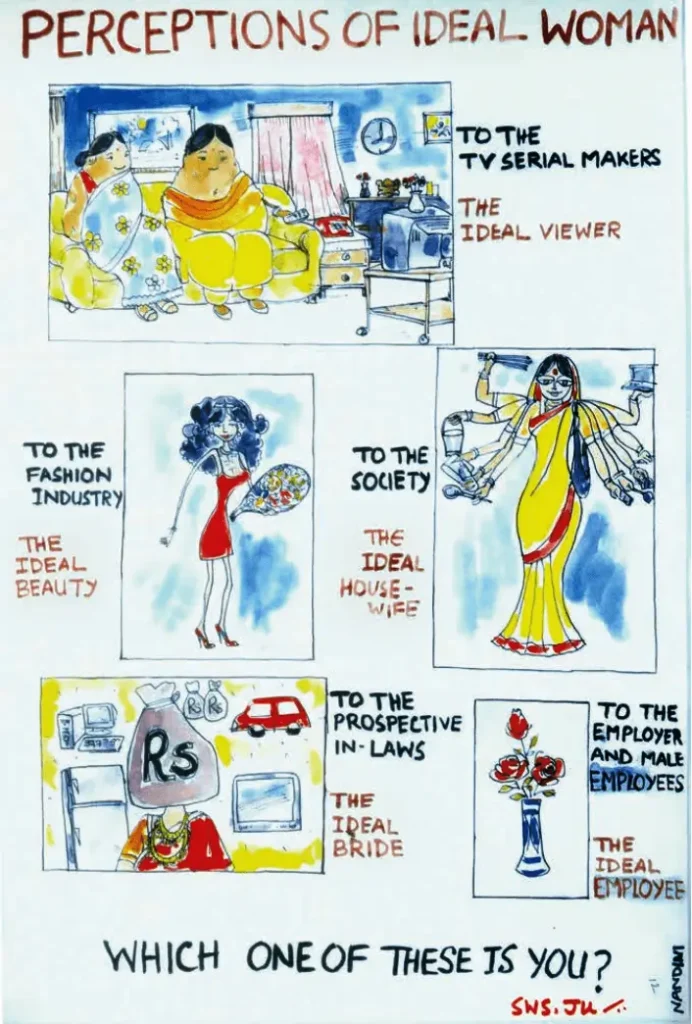
In my view women should not be tied in the image of an ideal woman. They should have equal rights and opportunities, to be what they want to be and live a life of good health and happiness.
Question.4. 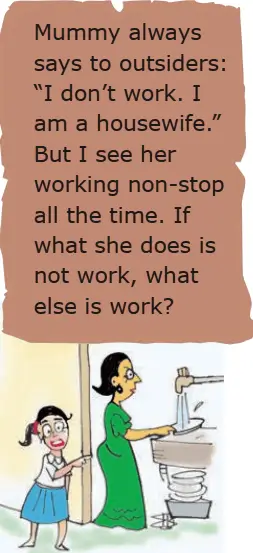
Women’s work should be given as much value as work done by them.
Question.5. 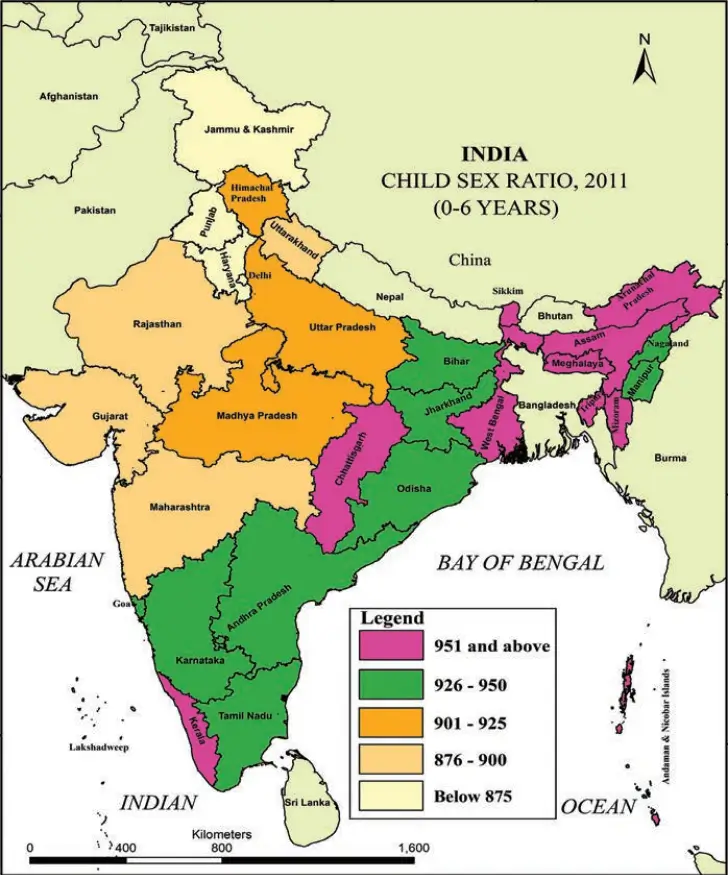
Ans. My state is Uttar Pradesh. Its child sex ratio is between 901 and 925 . Its range is shown in goldenrod colour.
(B) Identify the States which have child sex ratio below 900?
Ans. Maharashtra, Gujarat, Rajasthan, Uttarakhand, Haryana, Punjab and Jammu and kashmir.
(C) 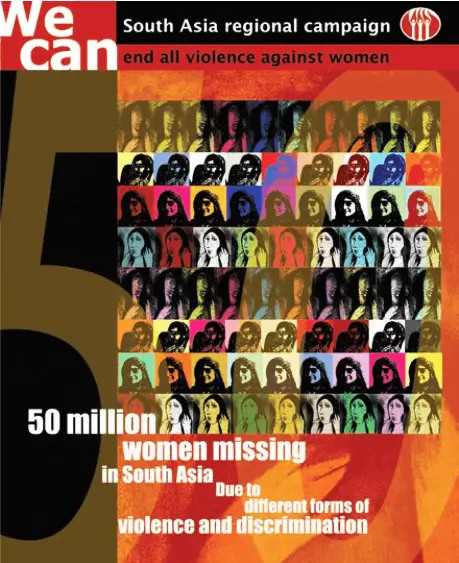
Ans. Both the map and poster are concerned about the decreasing trend of child sex ratio.
There are reports of various kinds of harassment, exploitation and violence against women. Urban areas have become particularly unsafe for women. They are not safe even within their own home from beating, harassment and other forms of domestic violence.
Question.6. 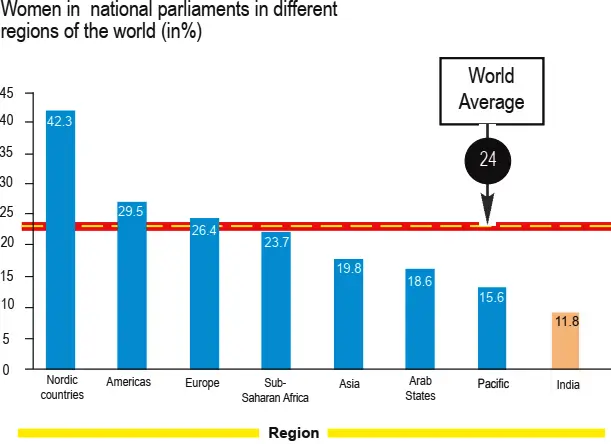
Ans. (i) The reasons for low level of women participation in politics are :
- Women’s literacy rate is very low. Even if some are educated, they are not politically motivated.
- Society thinks that politics is not the profession of women.
- Political parties are also not giving tickets to women candidates to fight elections in proportion to their population.
(ii) No, neither America’s nor Europe has achieved a satisfactory level of women’s representation. Because in America there are only 29.5 percent and in Europe only 26.4 percent women in the national parliament. These percentages are not proportional to their population in the respective countries.
Question.7. 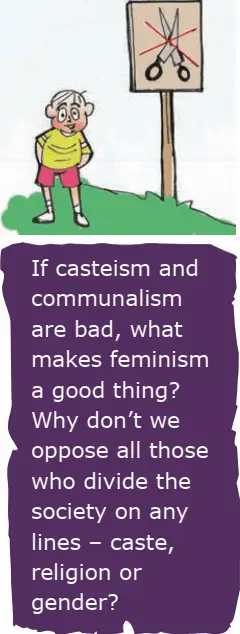
Question.8. 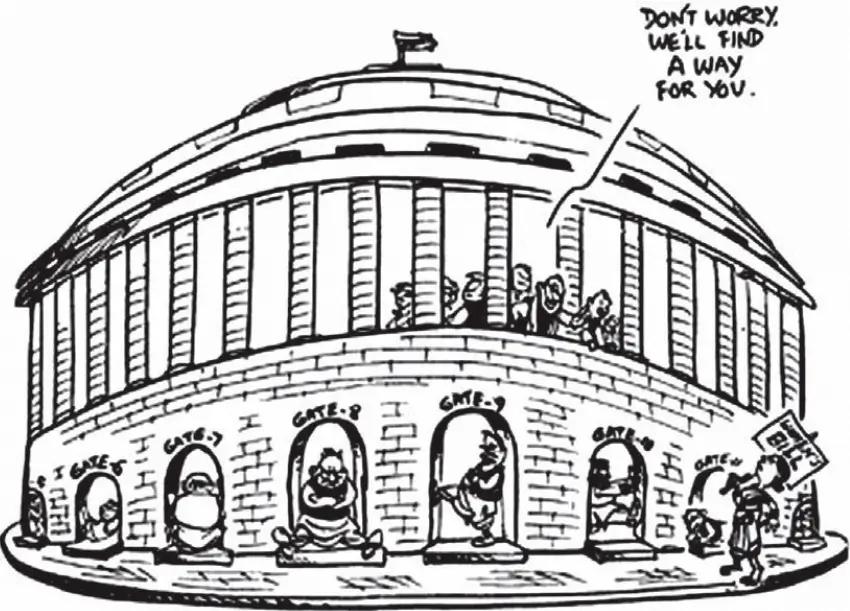
Ans. Yes, the cartoon reflects that our legislature is male – dominated. Every gate to the parliament is well guarded by men who do not wish women to enter the house. But, they pretend to show that very soon they are going to pass a bill regarding women’s reservation in the house.
Question.9. 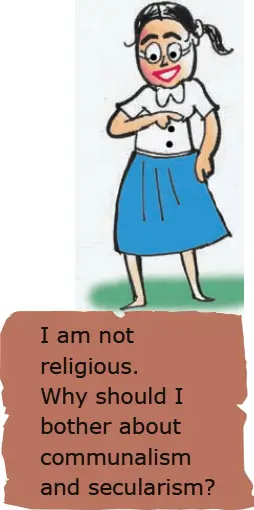
This attitude and activities that follow it harm the social system and the relations among the different religious communities.
So, you should also bother about communalism to make peace in the society.
Secularism means there is no state religion instead the state respects all religions equally. So, whether you are religious or not, you should also bother about the secularism so that there will not be any favour or discrimination against any religion. It will maintain a healthy atmosphere in the country.
Question.10. 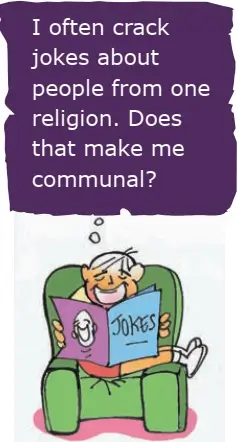
Question.11. 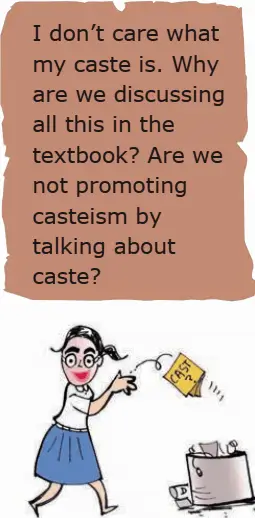
Question.12. 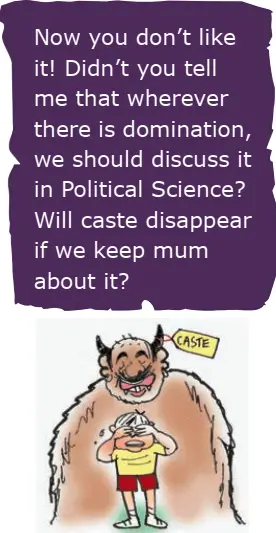
(ii) Caste will not disappear from India politics and from society merely by keeping mum about it. Because it has become a part and parcel of our political and social system.
Question.13. Do you think that political leaders are right to treat people belonging to a caste as ‘vote banks’?
TEXTBOOK EXERCISE
Question.1. Mention different aspects of life in which women are discriminated against or disadvantaged in India.
Ans.
- Women on the basis of gender have always been discriminated against in almost all the societies of the world including India. Ours is a patriarchal society. Women face disadvantage, discrimination, and oppression in various ways as mentioned below.
- Education: Women are deprived of equal access to education. Thus, the literacy rate among women is only 59.3 percent as compared to 78.8 percent among men.
- A smaller proportion of girl students go for higher education because in spite of their better performance than boys, they drop out as parents prefer to spend their resources for their son’s education, they do not want to spend equally on their sons and daughters.
- Discrimination in job opportunities and remuneration or salary : Under the Equal Wages Act, equal wages should be paid for equal work. In practice almost in every sphere, women are paid less than men, even when both do exactly the same work. On average an Indian woman works one hour more than an average man every day. Yet much of her work is not paid and therefore often not valued.
- Preference for sons: Even now in many parts of India, parents prefer to have sons. There are cases where a girl child is aborted before she is born. Due to sex-selective abortion, the sex-ratio has declined from 927 in 2001 to 850 or 800 in some places.
- Harassment against women: Women are being harassed by their employers at work. They are sexually assaulted at homes. They are not safe during their journey at night. They are subjected to various forms of domestic violence such as beating and harassment.
Question.2. State different forms of communal politics with one example each.
Ans. Communalism involves religious prejudices, stereotypes of religious communities and belief in the superiority of one’s religion over other religions.
A communal mind often leads to a quest for political dominance of one’s own religious community. Different forms of communal politics are:
- For those belonging to the majority community, this takes the form of majoritarian dominance.
- For those belonging to the minority community, it can take the form of a desire to form a separate political unit.
Question.3. State how caste inequalities are still continuing in India.
Ans. Caste is the dominant principle in contemporary India. Caste still persists in India even though it took new forms . Even now most people marry within their own caste or tribe. Untouchability has not ended completely, despite constitutional prohibition. The legacy of upper and lower castes is still felt today in the society.
Caste continues to be closely linked to economic status: The caste groups that had access to education under the old system have done very well in acquiring modern education as well. Those groups that did not have access to education or were prohibited from acquiring it have naturally lagged behind. That is why there is a disproportionately large presence of ‘upper caste’ among the urban middle classes in our country.
Question.4. State reasons to say that caste alone cannot determine election results in India.
Ans. The caste alone cannot determine election results in India because of the following reasons:
- No majority of one caste in a constituency : No parliamentary constituency in the country has a clear majority of one single caste. So, every candidate and party needs to win the confidence of more than one caste and community to win elections.
- No votes of one caste/community : No party wins the votes of all the voters of a caste or community. When people say that caste is a vote bank of one party, it usually means that a large proportion of the voters from that caste vote for that party.
- Candidates from the same caste : Many political parties may put up candidates from the same caste if that caste is believed to dominate the electorate in a particular constituency. All these factors divide the voters between two or more candidates.
- People within the same caste or community may have different interests depending on their economic condition. Rich and poor or men and women from the same caste often vote very differently.
- The ruling party and the sitting members frequently lose elections in our country. This could not have happened if all castes and communities were frozen in their political preferences. Sometimes the voters have strong attachment to political parties which is often stronger than their attachment to their caste or community. Thus it can be concluded that caste alone cannot determine election results in India.
Question.5. What is the status of women’s representation in India’s legislative bodies?
Ans. In India, the percentage of elected women in legislature is merely 12 percent of its total strength where they constitute 50% of the population. Their share in the state assemblies is less than 5 percent. In this respect, India is among the bottom group of nations in the world. India is behind the averages for several developing countries of Africa like Rwanda, Somalia and Latin America where women percentage in legislature crossed 50 percent. In the government, cabinets are largely all-male even when a woman becomes the Chief Minister or the Prime Minister.
Question.6. Mention any two constitutional provisions that make India a secular state.
Ans. Two constitutional provisions that make India a secular state are given below :
(1) India is a secular state as per preamble of the constitution. There is no official religion in India. Our Constitution does not give a special status to any religion like Islam in Pakistan, Buddhism in Sri Lanka and Christianity in England. State observes an attitude of neutrality and impartiality towards all religions.
(2) Under Article 25 of the Indian Constitution, it provides to all persons and communities freedom to profess, practice and propagate any religion or not to follow any.
Question.7. When we speak of gender divisions, we usually refer to :
(A) Biological difference between men and women.
(B) Unequal roles assigned by society to men and women.
(C) Unequal child sex ratio.
(D) Absence of voting rights for women in democracies.
Ans. (B) Unequal roles assigned by society to men and women.
Question.8. In India, seats are reserved for women in
(A) Lok sabha
(B) State legislative assemblies
(C) Cabinets
(D) Panchayati Raj bodies
Ans. (DPanchayati Raj bodies
Question.9. Consider the following statements on the meaning of communal politics:
Communal politics is based on the belief that :
(A) One religion is superior to that of others.
(B) People belonging to different religions can live together happily as equal citizens.
(C) Followers of a particular religion constitute one community.
(D) State power cannot be used to establish the domination of one religious group over others.
Which of the statements is/are correct?
(A) a, b, c and d
(B) a, b and d
(C) a and c
(D) b and d
Ans. (C) a and c
Question.10. Which among the following statements about India’s Constitution is wrong?
(A) Prohibits discrimination on grounds of religion.
(B) Gives official status to one religion.
(C) Provides to all individuals the freedom to profess any religion.
(D) Ensures the equality of citizens within religious communities.
Ans. (B) Gives official status to one religion.
Question.11. Social divisions based on ……………… are peculiar to India.
Ans. caste
Question.12. Match List I with List-II and select the correct answer using the codes given below the Lists:
| List-I | List-II |
|---|---|
| 1. A person who believes in equal rights and opportunities for women and men | A. Communalist |
| 2. A person who says that religion is the principal basics of community | B. Feminist |
| 3. A person who thinks that caste is the principal | C. Secularist |
| 4. A person who does not discriminate other on the basis of religious beliefs | D. Castiest |
| 1 | 2 | 3 | 4 | |
|---|---|---|---|---|
| (A) | B | C | A | D |
| (B) | B | A | D | C |
| (C) | D | C | A | B |
| (D) | C | A | B | D |
Ans. (B) B, A, D, C is the correct answer.




